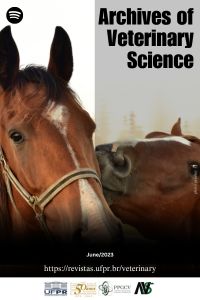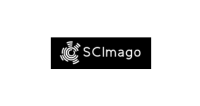A histopathologic and immunohistochemical comparison of corneal and conjunctival tissue from horses that were seropositive and seronegative for leptospirosis
DOI:
https://doi.org/10.5380/avs.v28i2.85966Palavras-chave:
horses, immunohistochemistry, leptospirosis, uveitis.Resumo
Equine recurrent uveitis (ERU) is the most common cause of blindness in horses. Leptospirosis has long been cited as a cause of ERU, particularly Leptospira interrogans serovar Pomona. Horses infected with the bacterium present several disorders, including uveitis, which alters the composition of the aqueous humor and impedes the nutrition of ocular structures, resulting in sequelae, such as iris atrophy, synechiae, and corneal changes. Previous studies have demonstrated that the opacity in both the cornea and lens is a consequence of the antigenic relationship between the bacteria and components of the ocular tissues and does not require the presence of living bacteria. In this study, blood samples, aqueous humor, and vitreous were obtained for microscopic agglutination test - MAT (SANTA ROSA, 1970) for leptospirosis from 29 horses (58 eyeballs). Histological and immunohistochemistry analysis of corneal and conjunctival tissue samples were performed and was noted that horses seropositive for leptospirosis exhibited corneal thickness significantly higher than the seronegative animals (P= 0.0347). This increase in thickness is probably due to the presence of inflammation. Evidence of inflammation, such as corneal blood vessels and inflammatory cell infiltrate was observed in a higher number of tissues from seropositive compared to seronegative horses. During immunohistochemistry, the anti-metalloproteinase 1 (anti-MMP1) of seropositive animals exhibited statistically significant results when compared to the area of immunohistochemistry reaction in seronegative animals (P=0008). Seropositive individuals had altered corneas (increased thickness and evidence of inflammation); therefore, inhibitory mechanisms of tissue metalloproteinases (TIMPs) in the cornea may be activated to prevent the degradation of corneal tissue during inflammation, resulting in the smallest reaction area of MMP1 in seropositive horses and a greater area in the seronegative individuals.
Downloads
Publicado
Como Citar
Edição
Seção
Licença
Autores que publicam nesta revista concordam com os seguintes termos:
- Autores mantém os direitos autorais e concedem à revista o direito de primeira publicação, com o trabalho simultaneamente licenciado sob a Creative Commons - Atribuição 4.0 Internacional que permite o compartilhamento do trabalho com reconhecimento da autoria e publicação inicial nesta revista.
- Autores têm autorização para assumir contratos adicionais separadamente, para distribuição não-exclusiva da versão do trabalho publicada nesta revista (ex.: publicar em repositório institucional ou como capítulo de livro), com reconhecimento de autoria e publicação inicial nesta revista.
- Autores têm permissão e são estimulados a publicar e distribuir seu trabalho online (ex.: em repositórios institucionais ou na sua página pessoal) a qualquer ponto antes ou durante o processo editorial, já que isso pode gerar alterações produtivas, bem como aumentar o impacto e a citação do trabalho publicado.














